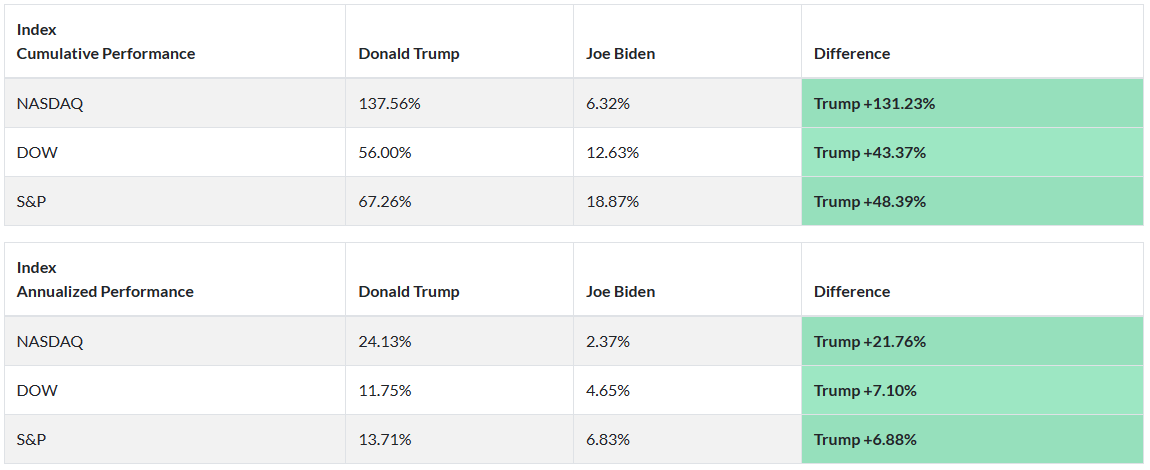The New Deal, Great Society & Bidenomics
by Michael Ozga
Centrally planned economies are economic malfeasance. They are social welfare schemes predicated upon government intervention, excessive regulation, tax & spend mentality, inhibited growth, high inflation, currency debasement, deficit spending and trillions of unfunded liabilities. Bidenomics ignores the mistakes of the Great Society as the Great Society ignored the mistakes of the New Deal. Insanity is doing the same thing over again and expecting different results.
President Franklin Delano Roosevelt 1933 – 1945 & the New Deal
The National Recovery Administration of 1933: Another New Deal and central planning canard. Spend enough money, pass enough legislation and give the impression of recovery. The NRA was enacted to set the price of labor, the price of goods, production quotas, &c. By years end some 700 Codes were enacted that resulted in 10,000 pages of legislation. These price-fixing mandates actually damaged small businesses by interfering with the natural laws of a free market. Despite its promise to create jobs through a federal bureaucracy, industrial production fell by 25% under the NRA. The Supreme Court dealt the NRA a fatal blow by ruling against it in 1935.
Social Security 1935: Accounts for $22.8 trillion of unfunded liabilities and represents 29% of all federal tax revenues. Social Security (Old Age Survivors Insurance) was also included on the Socialist Party Platform during the 1928 presidential election.
Social Security as percent of Federal Budget
- In 1940 Social Security represented 0.29% of Federal Budget
- In 1950 Social Security represented 1.83% of Federal Budget
- In 1960 Social Security represented 12.58% of Federal Budget
- In 1970 Social Security represented 15.47% of Federal Budget
- In 1980 Social Security represented 20.06% of Federal Budget
- In 1990 Social Security represented 19.83% of Federal Budget
- In 2000 Social Security represented 22.88% of Federal Budget
- In 2010 Social Security represented 21.00% of Federal Budget
- In 2010 Social Security represented 21.00% of Federal Budget
- In 2023 Social Security represents 21.00% of Federal Budget
- Spending on Social Security has increased by over 7000% since 1940. This social welfare scheme is clearly insolvent and unsustainable.
Economist Thomas Sowell describes SS as a pyramid scheme. Those who paid in first received money from those who paid in second and so forth, generation after generation. Economist Milton Friedman describes SS as a forced redistribution program whereby the government mandates everyone purchase a retirement plan and forcibly takes money from people to compel them to purchase the government plan…not a private alternative. The elderly in this country relies on SS because they are forced to. Social security is nothing but a quid pro quo, votes for entitlements. When questioned on the economics of SS,
FDR stated, “I guess you’re right on the economics, but those taxes were never a problem of economics. They are politics all the way through.”
As part of the original Senate debate on social security, Senator Clark of Missouri introduced the Clark Amendment, which would allow private employers to opt out. The Amendment would give employees the right to choose between a private alternative and the government-run annuity. Social Security was passed without the Clark Amendment but with the promise to review again in 1936. Once the government coerced annuity was implemented the promised meeting never occurred. The elderly in this country relies on social security because they were forced to. All we have at the time of retirement is an IOU from the government. We are not guaranteed the principal let alone any interest.
Debt: The national debt when FDR took office in 1933 stood at $22 plus billion. At the end of his 12- year tenure, the national debt was in excess of $158 billion, a twelve-fold increase. The failings of the New Deal are best summed up by FDR’s own
Treasury Secretary, Henry Morgenthau Jr in 1940. “We have tried spending money; we are spending more than we have ever spent before and it does not work. We have never made good on our promises…I say after eight years of this Administration we have just as much employment as when we started…and enormous debt to boot.”
Taxes: FDR enacted the undistributed profits tax, inheritance tax, estate tax, graduated corporate tax, dividend tax, and raised the top rate from 25% to 79%. These policies terrified business froze capital, inhibited growth and hiring. This is best described by economist Milton Friedman as the ‘Great Contraction.’ FDR and his New Deal policies turned a depression into a ‘Great Depression.’
The Crash of 1937: After five years of New Deal prime the pump spending, the economy experienced another major contraction from August – December 1937. The DJIA stood at 190 in August, fell to 114 in November and settled at 119 in December. As a result of the New Deal failures, foreign capital dropped by a factor of 20. During the 1920’s, foreign companies were investing approx. $1 billion per year in American stocks. That cratered to approx. $50 million per year during the 1930’s.
The legacy of FDR & the New Deal: The market crash of 1929 saw the Dow lose 13% of its value; a correction that President Coolidge had predicted years earlier. Hoover took this correction and turned it into a depression. FDR took a depression and turned it into the Great Depression. As a result of New Deal policies, it took the Dow until 1955 (26 years) to reach its previous high. To add perspective, the crash of 1987 saw the Dow lose 23% of its value. President Ronald Reagan allowed the free markets to self-correct as opposed to government intervention. As a result, the Dow returned to its previous high within 22 months.
President Lyndon Baines Johnson 1963 – 1969 and the Great Society
LBJ was an advocate of FDR’s New Deal, due to the sheer political feat. Like FDR, LBJ did not concern himself on whether the economics made sense, they did not. It was “political, all the way through.” Like FDR, the focus with LBJ was intentions and not results, a common denominator for the Progressive mindset.
The New Deal and Great Society were two sides of the same coin.
The War on Poverty 1964: Statement from staffers working for LBJ;
“Of course, there is no real solution to the problem of poverty until we abolish the capitalist system.” Like the New Deal programs before them, the War on Poverty produced nothing but
“bureaucratic make-work.” The poverty level in this country in 1965 was 14%, after decades of spending in excess of $20 trillion taxpayer dollars, the poverty level remains at 14%.
Medicare/Medicaid 1965: Accounts for $35 trillion of unfunded liabilities and accounts for 25% of the federal budget. Add $22 trillion in SS unfunded liabilities for a total of $57 trillion. These social welfare schemes account for 46% of the annual federal budget. Like its predecessor, social security, the elderly rely on Medicare because they are forced to. This is the Progressive mindset moving us towards socialized medicine.
Toyota 1965: Due to the incestuous relationship between big government, big business and labor unions, Toyota factories in Japan produced more vehicles per worker than the Big Three (GM, Ford, Chrysler) and UAW. The total cost per car in the US was five times that of Toyota. During the 1950s-1960s, GM, Ford and Chrysler controlled 85-90% of the automobile market. That is approx. 43% today.
Legacy of the Great Society: The central planners of the Great Society delivered ‘stagflation’ during the 1970s, high inflation, unemployment, trillions of unfunded liabilities, stagnant markets, deficit spending and currency debasement. LBJ/Great Society and FDR/New Deal demonstrated Keynesianism for what it is, window dressing for political expedience. The Great Society like the New Deal tried spending its way to prosperity. Prosperity did not come but big government did!
Joseph R. Biden 2021 – Present and Bidenomics
As author Amity Shlaes points out in her book
“Great Society: A New History,” just as the 1960s forgot the mistakes of the 1930s, we today forget the mistakes of the 1960s. Call it Progressivism, Keynesianism, modern monetary theory, demand side, tax and spend, New Deal, Great Society or Bidenomics; it is not working for Biden and did not work for either LBJ or FDR. The Congressional Budget Office estimates this year’s deficit to be approx. $2.0 trillion. If Biden were to serve two terms this translates to $16 trillion of additional debt on top of the $33 trillion, we have already accrued. To put into perspective, it took this country 222 years and 43 presidents, from George Washington to George Bush to accrue $10 trillion in debt. We’ve tripled that in just eleven short years.
Biden is doing his level best to recreate the centrally planned economies under FDR and LBJ. The premise is the same, spend enough money, pass enough legislation and give the impression of recovery.
- American Rescue Plan $1.9 trillion
- American Jobs Plan $2.3 trillion
- American Families Plan $1.8 trillion
- Infrastructure Bill $1 trillion
- CHIPS and Science Act $53 billion
- Inflation Reduction Act (aka Build Back Better) $2 trillion
- In excess of $100 billions of taxpayer money sent to Ukraine
- $9.63 trillion and counting. If we as a country have not yet crossed the Rubicon of economic collapse, we are certainly on the precipice!
Free Markets vs. Central Planning
Energy Independence: In December 2020 the USA was energy independent. In fact, we were selling our surplus to other countries. Our strategic oil reserves were also at capacity. Today we are buying oil from foreign adversaries as a matter of choice. We have also depleted our strategic oil reserves to roughly half. We have an abundance of fossil fuels (coal, gas, oil) that are clean burning, cheap and efficient. Estimates place our surplus at between 150-200 years. This provides ample time to explore alternative means of energy such as wind and solar. However, this transfer to an alternative energy should happen as a natural byproduct of creative destruction. It should not be fast tracked to appease a political ideology. The lifeblood of the world’s economy is fossil fuels and will remain so until if/when an alternative means proves to be abundant, reliable and cheap. Bidenomics has ceded our energy independence to foreign adversaries as a matter of choice and political expedience. The results have been economic suicide and can be felt throughout the entire economy. The price comparisons below bear this out and are all self-inflicted.
December 2020 – September 2023
- Heating Oil (Maine) $1.99/gal (Dec 2020) $4.00/gal (Sept 2023) Increase of 101%
- Premium Gas (Maine) $2.58/gal (Dec 2020) $3.99/gal (Sept 2023) Increase of 55%
- Regular Gas (Maine) $2.17/gal (Dec 2020) $3.55/gal (Sept 2023) Increase of 64%
- Electricity (Maine) $0.176/kWh (Dec 2020) $0.356/kWh (Sept 2023) Increased of 102%
- Groceries (Maine) $453/month (dec 2020) $618/month (Sept 2023) Increase of 36%
- Inflation Average 1.2% (dec 2020) 6.76% (Sept 2023) Increased of 463%
- Fed Interest Rates 0.25% (Dec 2020) 5.5% (Sept 2023) Increased of 2100%
- 30-year fixed mortgage 2.7% (Dec 2020) 7.23% (Sept 2023) Increased of 167%
The Invisible Hand: Adam Smith is generally considered the father of modern economics. His seminal treatise,
“The Wealth of Nations,” was published in 1776 and continues to have a profound influence in economics, philosophy, history and sociology. Among those Smith influenced were our Founding Fathers, including Benjamin Franklin, Thomas Jefferson, Alexander Hamilton and Samuel Adams. The book describes a market economy that is based upon individual liberty and self-interest. The economy Smith describes is one that allows the individual to interact in markets on their own accord absent any interference from outside sources. The individual is led by an
“invisible hand” in pursuit of his own self-interest. Individual exchange in a free marketplace result in the greatest good for society.
Smith points out that the individual is a better steward of his capital than any statesman (i.e., central planner). True in 1776, true in 2023.
“The statesman, who should attempt to direct private people in what manner they ought to employ their capitals, would not only load himself with a most unnecessary attention, but assume an authority which could safely be trusted, not only to no single person, but to no council or senate whatever, and which would nowhere be so dangerous as in the hands of a man who had folly and presumption enough to fancy himself fit to exercise it.” Written almost 250 years ago yet
“folly and presumption” describe the central planning of the New Deal, Great Society and Bidenomics.
Legacy of Bidenomics: Economic malfeasance that threatens our standard of living as well as our national security. A top-down social welfare state will eventually collapse. A state that does not secure its sovereign borders will do the same. Bidenomics combines the two mutually exclusive policies that most assuredly will guarantee our demise.
“Make everything as simple as possible, but not simpler.” Albert Einstein
Coolidge, JFK & Reagan: President Calvin Coolidge (1923-1929), President John F. Kennedy (1961-1963) and Ronald Reagan (1981-1989) kept it simple, sound fiscal and monetary policies led to prosperity.
1920-1929: The top tax rate dropped from 73% – 24%. Reported income of the top 1% increased by 30%, GDP rose by 45%, the percent of federal taxes paid by the top 1% increased form 38%-66%. Foreign capital invested approx. $1 billion per year in US stocks during the 1920’s (this cratered to $50 million per year during the 1930’s). The federal government ran a budget surplus throughout the 1920’s. The DJIA stood at 72.67 when Harding took office and closed at 248.48 when Coolidge left office (increase of 242%). The national debt stood at $24 billion when Harding took office, it was reduced to $17 billion as Coolidge left office. In 1921 there were 5.7 million Americans unemployed. That figure dropped to 1.8 million by 1929 as manufacturing grew by 33% while iron and steel production doubled. This process began under President Warren Harding (1921-1923) and continued under President Coolidge (1923-1929) and saw the economy grow as the federal government shrank.
1961-1969: Kennedy inherited an economy that experienced four recessions during the previous eleven years (1949-1960). President Eisenhower (1953-1961) ignored the advice of his administration to cut taxes and opted for the classic Keynes approach; boost government spending to spur the economy. By 1960 the economy had experienced its fourth recession in a decade. Unemployment was stuck at 6% while economic growth was a paltry 2.3% per year. From 1957 to the end of 1960 the private sector grew at 1.5% per year while government grew at 4.3% per year. JFK began his term in true Keynesian fashion; government spending would prime the pump and lead to economic growth, it did not. In 1962, Kennedy finally agreed to his Treasury’s recommendation: supply-side economics.
Kennedy on the progressive tax system;
“Our tax rates, in short, are so high as to weaken the very essence of the progress of a free society, the incentive for additional return for additional effort…progressive taxation makes it less and less profitable to succeed.” Kennedy realized that every dollar released from taxation (government spending) will create new jobs and expand the American economy. President Kennedy was assassinated on November 22, 1963. As a memorial to JFK, Johnson pushed Kennedys tax cut bill through the Senate and signed it into law on February 26, 1964. The Revenue Act of 1964 reduced the tax rate schedule from a percent range of 20-91 (under Eisenhower) to a percent range of 14-70. The corporate tax rate was cut from 52 to 48 percent. This resulted in GDP growth of 5% annually, a pace not seen since the 1920’s. Median family income increased, and Americans doubled their savings. State and local revenues went up 40%. Federal spending decreased from 1964-1965, a first since 1955. The tax cuts freed up capital from tax shelters and allowed it to flow into the real economy.
Unfortunately, the prosperity ushered in by the Kennedy tax cuts would prove to be a brief and shining moment. After 1965, the budget surplus trend reversed course and by 1968 federal spending increased by 38% in three years. LBJ had returned to his FDR (Keynesian) roots with his initiative of the Great Society and subsequent social welfare spending. The trillions spent on Great Society welfare has unfortunately done nothing more than entrench poverty.
1969-1980: President Richard M. Nixon (1969-1974) learned nothing from the mistakes of his former boss (President Eisenhower) or predecessor (LBJ) on the deleterious effects of high taxes and government spending. The reversal of the JFK fiscal/monetary policy started with JBJ and continued under Nixon. The combination of misguided fiscal policy (higher taxes) and misguided monetary policy (Fed expanding money supply) led to a recession and inflation. Over the first two years of Nixon’s tenure economic growth was a cumulative 0.36%. By 1973 inflation hit 6 percent, 11 percent in 1974 and 9 percent in 1975. Economist Alan Reynolds described Nixon’s economic policy,
“It was the government itself that brought on the current crisis through excess monetary creation, oppressive taxation and bureaucratic self-indulgence.”
Under Nixon than Gerald Ford (1974-1977), the economy spent 16 months in recession from 1973-1975. The economy was stagnant while inflation crept up. By 1975 the misery index (unemployment plus inflation) was 18 percent. President Jimmy Carter (1977-1981) continued the insane policies of Nixon and Ford; by 1980 the economy recorded two consecutive years of double-digit inflation. Outside of war mobilization, the double-digit inflation of 1979-1980 was a first. By years end of 1980 the misery index was 21 percent. By 1980 the price of oil had increased elevenfold since 1973, gold soared from $35 per ounce (1971) to $800 per ounce. The policy mix of Nixon, Ford and Carter included the ending of gold redemption, high taxes (fiscal policy), easy money (monetary policy), government spending, double digit inflation, misery index of 21 percent,
1981-1989: The economy was in freefall when President Ronald Reagan (1981-1989) took office. During the fall and winter of 1981-1982 the economy was contracting at an annual rate of 5.6 percent while unemployment peaked at 10.8 percent. Reagan pushed through a tax cut of 5 percent in 1981, 10 percent in 1982 and 10 percent in 1983. The top rate was cut from 70 to 50 than 28 percent. The sound fiscal policy of tax cuts was coupled with sound monetary policy of tracking gold. By 1983 economic growth in the first quarter was 5.3 percent. Over the next five consecutive quarters economic growth eclipsed 7 percent. By the end of Reagan’s second term nineteen million jobs were created, double digit inflation evaporated, prices for oil and gold fell, capital shifted to stocks, the dollar was strong, and entrepreneurialism flourished.
Free Markets vs. Government Intervention: The DOW lost 23% of its value on Black Monday, October 19, 1987. Reagan allowed the markets to self-correct, and the DOW returned to its previous high within 22 months. The DOW lost 13% of its value on Black Monday, October 28, 1929. President Herbert Hoover (1929-1933) ignored the advice from Coolidge in 1926 against government intervention. Hoover turned a simple correction into a recession than depression. FDR and the New Deal via massive intervention turned a depression into a great depression. As a result, the DOW did not return to its 1929 high until 1955.
Triumvirate of Failure
FDR, LBJ & Biden: The New Deal, Great Society and Bidenomics have been and are currently abysmal failures by all objective standards. This triumvirate of economic malfeasance is responsible for creating a great depression, currency debasement, unemployment, double digit inflation, trillions of unfunded liabilities, unfathomable debt, top-down social welfare policy, deficit financing, entrenched poverty, high tax rates (fiscal policy), easy money (monetary policy), highly regulated environment, ceding our energy independence to foreign adversaries, depletion of strategic oil reserves, unabated illegal immigration, &c…
This occurs when the Fed (monetary policy) and income tax (fiscal policy) serve as activist.
“My reading of history convinces me that most bad government results from too much government.” Thomas Jefferson
Triumvirate of Success
Coolidge, JFK, Reagan: Cuts in tax rates particularly at the top, tax cuts free up capital from shelters to invest in real economy, budget surplus, sound dollar, national debt reduced (Coolidge), millions of private sector jobs created, foreign capital invested in US stocks, median family income increases, low unemployment, low inflation, entrepreneurialism flourished, &c…
This occurs when the Fed (monetary policy) and income tax (fiscal policy) are modest.
“To be ignorant of the past is to be forever a child.” Cicero








0 Comments